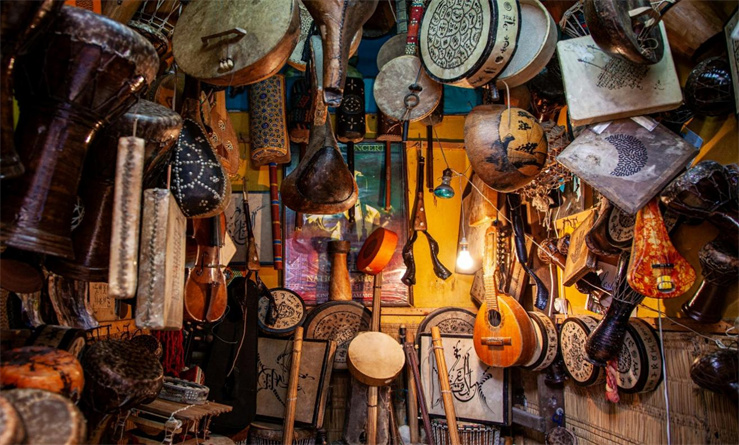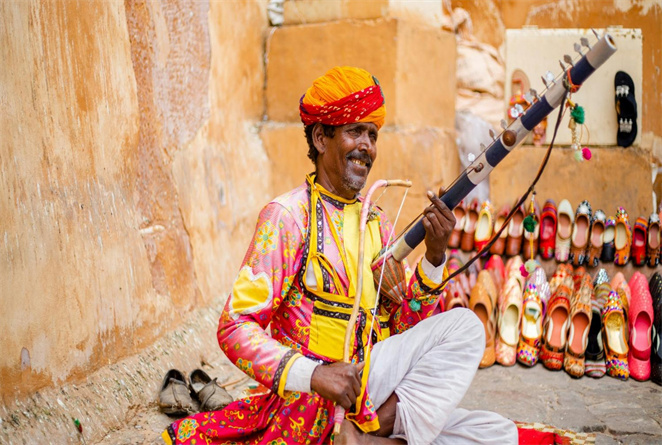Top 10 Classic Traditional Music of All Time
Traditional music, a timeless cultural treasure, serves as a living testament to the rich tapestry of human expression and heritage. In this article, let’s delve into the essence of traditional music, its historical roots, and its defining characteristics and explore 10 classic traditional music of all time and answers to some frequently asked questions.

Part 1: What is Traditional Music?
Traditional music emerged organically throughout history and encompasses a diverse array of musical styles and genres rooted in the customs, beliefs, and cultural heritage of various communities around the world. From the festive tunes of traditional Christmas music to the spirited melodies of traditional Irish music, each genre reflects the unique identity and legacy of its respective culture.
The History of Traditional Music
The history of traditional music traces back to ancient origins where music served as a fundamental aspect of communal life and cultural expression. It evolved over centuries through oral transmission and cultural exchanges.
Key Characteristics of Merengue Music
- Ancient Origins (Prehistoric times to c. 500 CE):
- Medieval Period (c. 500 CE to c. 1500 CE):
- Colonial Influences (15th century to 19th century):
- Revival Movements (19th century to early 20th century):
- Recording Industry (Late 19th century to early 20th century):
- Festival and Cultural Celebrations (20th century to present):
The earliest known evidence of traditional music dates back to prehistoric times, with archaeological findings indicating the use of musical instruments.
Traditional music flourished during the medieval era, with troubadours, minstrels, and court musicians performing songs and instrumental pieces inspired by folklore and regional traditions across Europe, Asia, and Africa.
The era of European colonization in the Americas, Africa, and Asia led to significant cultural exchanges and the blending of musical traditions. Traditional music evolved as indigenous styles intermingled with European, African, and Asian influences, giving rise to hybrid genres.
In the 19th century, there was a resurgence of interest in traditional music, spurred by folk music collectors and scholars who documented and preserved traditional songs, dances, and musical practices.
The advent of recording technology revolutionized the dissemination of traditional music, with commercial recordings enabling wider audiences to access and appreciate folk and traditional music from different cultures.
Throughout the 20th century and into the 21st century, traditional music festivals and cultural celebrations have played a crucial role in showcasing and preserving folk and traditional music traditions worldwide.
Characteristics of Traditional Music
Traditional music is known for its distinctive features that create a tranquil and immersive listening experience. Here are some key characteristics:
- Cultural Heritage
- Instrumental
- Narrative and Storytelling
- Transmission
Traditional music embodies the cultural heritage and identity of specific regions or communities, such as Irish traditional music or traditional Chinese music. It reflects the customs, values, and experieces unique to each culture, serving as a profound expression of collective identity.
Traditional music often features distinctive instrumentation and stylistic elements that are characteristic of the culture from which it originates. For example, traditional Japanese music may utilize traditional instruments like the koto or shamisen, while traditional Mexican music may incorporate indigenous instruments such as the mariachi or jarana.
Traditional music frequently incorporates narrative elements, conveying stories, legends, or historical events significant to the cultural context. Irish traditional music songs, often tell tales of love, loss, and rebellion, while traditional Christmas music narrates biblical stories.
Traditional music is typically transmitted orally or through informal means, such as apprenticeships or community gatherings. This mode of transmission ensures the preservation of the music's authenticity and cultural integrity.

Part 2: 10 Classic Traditional Music from Different Countries
Let’s discover a captivating array of classic traditional music from around the globe, each representing the unique cultural heritage and musical traditions of its respective country.
- 1.China
- 2.Japan:
- 3.Mexico:
- 4.Greece:
- 5.Italy:
- 6.South Korea:
- 7.Germany:
- 8.Spain:
- 9.United States:
- 10.Ireland:
Traditional Chinese music is characterized by its rich history and diverse regional styles. Instruments such as the guzheng (zither), erhu (two-stringed fiddle), and pipa (lute) feature prominently, producing melodies that reflect themes of nature, philosophy, and ancient legends.
Japanese traditional music, also known as music japan traditional, encompasses a wide range of genres, including gagaku (court music), min'yo (folk songs), and kabuki music. Instruments like the koto (13-stringed zither), shakuhachi (bamboo flute), and shamisen (three-stringed lute) are central to traditional Japanese music ensembles, creating a serene and contemplative atmosphere.
Traditional Mexican music is known for its vibrant rhythms, colorful melodies, and diverse regional styles. Genres like mariachi, ranchera, and corrido are popular expressions of Mexican musical tradition, featuring instruments such as the trumpet, violin, guitarrón (bass guitar), and vihuela (small guitar).
Greek music accompanies celebrations, weddings, and social gatherings, reflecting the country's cultural heritage and rich musical heritage. Traditional Greek music is characterized by its passionate melodies, intricate rhythms, and diverse regional styles. Genres like rebetiko, laiko, and dimotika are prominent expressions of Greek musical tradition, featuring instruments such as the bouzouki, baglamas, and lyra.
Traditional Italian music encompasses a wide range of genres, including opera, folk songs, and regional music styles. Opera, with its grandiose arias and dramatic storytelling, is one of Italy's most renowned musical traditions, while folk songs and dances like tarantella and pizzica capture the spirit of different Italian regions. Instruments such as the mandolin, accordion, and tambourine are commonly used in traditional Italian ensembles.
Korean traditional music is characterized by its soulful melodies, dynamic rhythms, and diverse regional styles. Genres like court music (gagaku), folk songs (min'yo), and percussion ensembles (samulnori) are prominent expressions of Korean musical tradition, featuring instruments such as the gayageum (zither), daegeum (bamboo flute), and janggu (hourglass drum).
One can experience the festive spirit and cultural heritage of Germany through traditional German music, including polkas, waltzes, and folk songs that are an integral part of the country's rich musical tapestry.
Traditional Spanish music encompasses genres like flamenco, regional folk songs, and classical guitar music. Flamenco, with its passionate singing, guitar playing, and dance, is one of Spain's most iconic musical traditions.
Classic Christmas traditional music in the United States encompasses a wide range of genres, from traditional carols like "Silent Night" and "Jingle Bells" to popular songs like "White Christmas" and "Rudolph the Red-Nosed Reindeer." These timeless melodies evoke the spirit of the holiday season and are often performed by choirs, orchestras, and solo artists.
Irish traditional music is deeply rooted in the country's history and folklore, featuring lively dance tunes like jigs, reels, and hornpipes, as well as poignant ballads and laments. Instruments such as the fiddle, tin whistle, uilleann pipes, and bodhrán (Irish drum) are commonly used in traditional Irish ensembles, creating a dynamic and expressive sound.
Part 3: How to Get the Traditional Music Genre?
For those looking to create traditional music, the HitPaw AI Music Generator is a powerful tool that simplifies the process. It uses artificial intelligence to generate music based on your preferences. The pros and cons of using the HitPaw generator are mentioned below:
Pros
- User-friendly interface makes it simple to navigate and operate.
- Provides extensive customization options, catering to diverse musical preferences.
- Efficient music generation process allows for quick creation of compositions.
Cons
- Compared to traditional music production methods, there's less control over the final
- Utilizing AI features necessitates an active internet connection.
Watch the following video to learn more details:
Part 4: FAQs of Traditional Music
Q1. What is considered traditional music?
A1. Traditional music typically refers to music that is rooted in the customs, beliefs, and cultural heritage of a specific region or community. It is often passed down orally from one generation to another and reflects the unique identity and legacy of the culture from which it originates.
Q2. Why is traditional music important?
A2. Traditional music preserves cultural heritage, fostering identity and social cohesion. It offers insights into history and societal values while serving as a platform for artistic expression and education. Through melodies and lyrics, it unites communities, transcending barriers and inspiring future generations.
Part 5: Final Word
In conclusion, traditional music stands as a timeless cultural treasure, embodying the rich tapestry of human expression and heritage. By exploring 10 classic traditional music genres from around the world, we've delved into the diverse cultural heritage and musical traditions that shape our global community.
For those looking to create traditional music, the HitPaw AI Music Generator offers a convenient and efficient solution and provides a gateway to explore and appreciate the timeless allure of this musical genre.







 HitPaw Video Object Remover
HitPaw Video Object Remover HitPaw Photo Object Remover
HitPaw Photo Object Remover HitPaw VikPea (Video Enhancer)
HitPaw VikPea (Video Enhancer)


Share this article:
Select the product rating:
Daniel Walker
Editor-in-Chief
My passion lies in bridging the gap between cutting-edge technology and everyday creativity. With years of hands-on experience, I create content that not only informs but inspires our audience to embrace digital tools confidently.
View all ArticlesLeave a Comment
Create your review for HitPaw articles